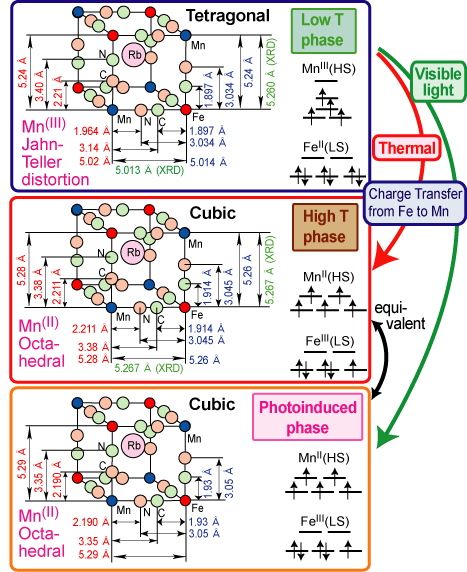| >Research>Photoinduced phase in RbMnFe(CN)6 |

Photoinduced phase transition of RbMnFe(CN)6 studied
by x-ray-absorption fine structure spectroscopy
| 戻る | back |
|
Molecular-based magnets provide noble properties such as photoinduced magnetism. Photoinduced phase transition is closely related to bistability of the ground state in the material. Light irradiation stimulates the macroscopic phase transition between the ground state and the metastable state, although thermal fluctuation triggers the thermal phase transition. Although it has been believed that the photoinduced phase is the same state as the thermally induced phase, recent investigations have reported some differences in structure from the high-temperature phase. We have been studying local structures and electronic properties of photoinduced phases of Prussian-blue analogues and other metal-complex magnets by means of x-ray absorption fine structure (XAFS) spectroscopy. XAFS is one of the most suitable methods for these purposes since the technique does not require long-range order in the sample and provide element-specific information about each metal atom. A Prussian-blue analogue of RbMnFe(CN)6 shows a thermally induced first-order phase transition (Tc(down)=231 K and Tc(up)=304 K) and also turns to a ferromagnetic phase below 12 K. Upon visible-light irradiation, the ferromagnetism is quenched and the phase is transformed to the metastable nonmagnetic state. In this work, we have investigated the photoinduced magnetic phase transition of RbMnFe(CN)6 by means of XAFS spectroscopy (T. Yokoyama, H. Tokoro, S. Ohkoshi, K. Hashimoto, K. Okamoto and T. Ohta). Mn and Fe K-edge x-ray-absorption near-edge structure spectra have clarified that upon the phase transition, a Fe 3d electron is transferred to the Mn d level; the electronic state of Mn changes from trivalent (d4, spin momentum S=2) to divalent (d5, S=5/2), while the Fe state correspondingly varies from divalent (d6, S=0) to trivalent (d5, S=1/2). Such a tautomeric scheme in the photoinduced phase transition is exactly the same as in the thermally induced transition. Local structures have been investigated by the extended x-ray-absorption fine-structure analysis for the photoinduced phase as well as for the low- and high-temperature phases. The low-temperature phase shows a significant Jahn-Teller distortion in the Mn(III) octahedron, where the Mn-N distances for four shorter and two longer bonds are 1.964±0.008 Ang. and 2.21±0.01 Ang., respectively. The high-temperature phase gives a longer Mn-N distance of 2.211±0.006 Ang., although some minor contribution from a shorter distance still remains. It is also revealed that the atomic configuration of the -Fe-C-N-Mn- chain is essentially collinear and that the Rb ions locate at the center of the cubic lattice. The photoinduced phase was found to be structurally and electronically identical to the high-temperature phase. Summary of the present investigation is given in Figure.  Figure: Summary of the present investigation for the phase transitions in RbMnFe(CN)6. |